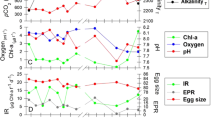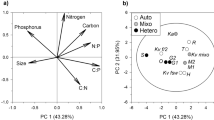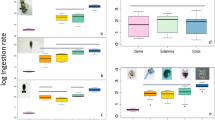Abstract
Diatoms dominate spring bloom phytoplankton assemblages in temperate waters and coastal upwelling regions of the global ocean. Copepods usually dominate the zooplankton in these regions and are the prey of many larval fish species. Recent laboratory studies suggest that diatoms may have a deleterious effect on the success of copepod egg hatching1,2,3,4. These findings challenge the classical view of marine food-web energy flow from diatoms to fish by means of copepods5,6,7. Egg mortality is an important factor in copepod population dynamics8, thus, if diatoms have a deleterious in situ effect, paradoxically, high diatom abundance could limit secondary production. Therefore, the current understanding of energy transfer from primary production to fisheries in some of the most productive and economically important marine ecosystems9 may be seriously flawed1,10. Here we present in situ estimates of copepod egg hatching success from twelve globally distributed areas, where diatoms dominate the phytoplankton assemblage. We did not observe a negative relationship between copepod egg hatching success and either diatom biomass or dominance in the microplankton in any of these regions. The classical model for diatom-dominated system remains valid.
This is a preview of subscription content, access via your institution
Access options
Subscribe to this journal
Receive 51 print issues and online access
$199.00 per year
only $3.90 per issue
Buy this article
- Purchase on Springer Link
- Instant access to full article PDF
Prices may be subject to local taxes which are calculated during checkout

Similar content being viewed by others
References
Miralto, A. et al. The insidious effect of diatoms on copepod reproduction. Nature 402, 173–176 (1999)
Ban, S. et al. The paradox of diatom-copepod interactions. Mar. Ecol. Prog. Ser. 157, 287–293 (1997)
Uye, S. Induction of reproductive failure in the planktonic copepod Calanus pacificus by diatoms. Mar. Ecol. Prog. Ser. 133, 89–97 (1996)
Paffenhöfer, G.-A. An assessment of the effects of diatoms on planktonic copepods. Mar. Ecol. Prog. Ser. 227, 305–310 (2002)
Cushing, D. H. A difference in structure between ecosystems in strongly stratified waters and in those that are weakly stratified. J. Plankton Res. 11, 1–13 (1989)
Legendre, L. The significance of microalgal blooms for fisheries and for the export of particulate organic carbon in oceans. J. Plankton Res. 12, 681–699 (1990)
Runge, J. A. Should we expect a relationship between primary production and fisheries? The role of copepod dynamics as a filter of trophic variability. Hydrobiologia 167/168, 61–71 (1988)
Ohman, M. D. & Hirche, H.-J. Density-dependent mortality in an oceanic copepod population. Nature 412, 638–641 (2001)
Pauly, D. & Christensen, V. Primary production required to sustain global fisheries. Nature 374, 255–257 (1995)
Ianora, A., Miralto, A. & Poulet, S. A. Are diatoms good or toxic for copepods? Reply to comment by Jónasdóttir et al. Mar. Ecol. Prog. Ser. 177, 305–308 (1999)
Jónasdóttir, S. H. et al. Role of diatoms in copepod production: good, harmless or toxic? Mar. Ecol. Prog. Ser. 172, 305–308 (1998)
Poulet, S., Ianora, A., Miralto, A. & Meijer, L. Do diatoms arrest embryonic development in copepods? Mar. Ecol. Prog. Ser. 111, 79–86 (1994)
Ianora, A., Poulet, S. A., Miralto, A. & Grottoli, R. The diatom Thalassiosira rotula affects reproductive success in the copepod Acartia clausi. Mar. Biol. 125, 279–286 (1996)
Pohnert, G. Wound-activated chemical defense in unicellular planktonic algae. Angew. Chem. Int. Edn 39, 4352–4354 (2000)
Peterson, W. T. Patterns in stage duration and development among marine and freshwater calanoid and cyclopoid copepods: a review of rules, physiological constraints, and evolutionary significance. Hydrobiologia 453/454, 91–105 (2001)
Irigoien, X. et al. Feeding selectivity and egg production of Calanus helgolandicus in the English Channel. Limnol. Oceanogr. 45, 44–54 (2000)
Irigoien, X., Harris, R. P., Head, R. N. & Harbour, D. The influence of diatom abundance on the egg production rate of Calanus helgolandicus in the English Channel. Limnol. Oceanogr. 45, 1433–1439 (2000)
Runge, J. A. & Roff, J. C. ICES Zooplankton Methodology Manual (eds Harris, R. P., Wiebe, P. H., Lenz, J., Skjoldal, H. R. & Huntley, M. E.) 401–454 (Academic, London, 2000)
Holligan, P. M. & Harbour, D. S. The vertical distribution and succession of phytoplankton in the western English Channel in 1975 and 1976. J. Mar. Biol. Assoc. UK 57, 1075–1093 (1977)
Strathmann, R. R. Estimating the organic carbon content of phytoplankton from cell volume or plasma volume. Limnol. Oceanogr 12, 411–418 (1967)
Ohman, M. D. & Runge, J. A. Sustained fecundity when phytoplankton resources are in short supply: omnivory by Calanus finmarchicus in the Gulf of St Lawrence. Limnol. Oceanogr. 39, 21–36 (1994)
Lessard, E. J. & Swift, E. Dinoflagellates from the North Atlantic classified as phototrophic or heterotrophic by epifluorescence microscopy. J. Plankton Res. 8, 1209–1215 (1986)
Acknowledgements
This is a contribution to the international GLOBEC (Global Ocean Ecosystem Dynamics) programme. We thank the captains and crews of the research vessels who made this work possible.
Author information
Authors and Affiliations
Corresponding author
Ethics declarations
Competing interests
The authors declare that they have no competing financial interests.
Supplementary information
Rights and permissions
About this article
Cite this article
Irigoien, X., Harris, R., Verheye, H. et al. Copepod hatching success in marine ecosystems with high diatom concentrations. Nature 419, 387–389 (2002). https://doi.org/10.1038/nature01055
Received:
Accepted:
Issue Date:
DOI: https://doi.org/10.1038/nature01055
This article is cited by
-
Assessing the effects of silicate addition on phytoplankton composition and copepod production in an inorganic fertilization system
Aquaculture International (2024)
-
Mechanisms and magnitude of dissolved silica release from a New England salt marsh
Biogeochemistry (2022)
-
A New Type of Ecological Floating Bed Based on Ornamental Plants Experimented in an Artificially Made Eutrophic Water Body in the Laboratory for Nutrient Removal
Bulletin of Environmental Contamination and Toxicology (2021)
-
Production of the Copepod Pseudodiaptomus forbesi Is Not Enhanced by Ingestion of the Diatom Aulacoseira granulata During a Bloom
Estuaries and Coasts (2021)
-
Effects of prey trophic mode on the gross-growth efficiency of marine copepods: the case of mixoplankton
Scientific Reports (2020)
Comments
By submitting a comment you agree to abide by our Terms and Community Guidelines. If you find something abusive or that does not comply with our terms or guidelines please flag it as inappropriate.



